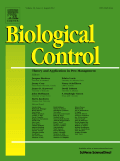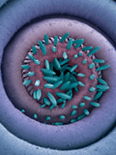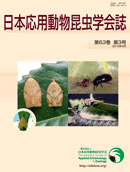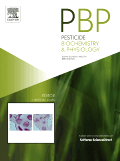
BIOLOGICAL CONTROL
Scope & Guideline
Innovating Biological Strategies for Ecological Balance
Introduction
Aims and Scopes
- Microbial Biocontrol Agents:
Research on bacteria, fungi, and other microorganisms as biocontrol agents, including their mechanisms of action, efficacy against specific pathogens, and their roles in enhancing plant defenses. - Insect and Arthropod Biocontrol:
Studies focusing on the use of predatory and parasitic insects for biological control of pest species, including investigations into their behavior, life history, and ecological interactions. - Ecological and Environmental Impacts:
Examination of the ecological implications of introducing biocontrol agents into new environments, including potential non-target effects and ecosystem dynamics. - Integrated Pest Management (IPM) Strategies:
Development and evaluation of integrated approaches combining biological control with other pest management tactics to enhance efficacy and sustainability. - Plant-Microbe Interactions:
Exploration of the interactions between plants and their associated microorganisms, particularly how these relationships can be harnessed for biocontrol purposes. - Weed Biocontrol:
Research on biological control methods for managing invasive plant species, including the identification and release of specific biocontrol agents.
Trending and Emerging
- Endophytic Microorganisms:
There is an increasing focus on the role of endophytic bacteria and fungi as biocontrol agents, particularly their ability to enhance plant resistance to pathogens and pests. - Genomic and Molecular Approaches:
Research utilizing genomic and transcriptomic analyses to understand the mechanisms of action of biocontrol agents is on the rise, providing deeper insights into their functionality. - Climate Change Adaptation:
Studies addressing the effects of climate change on the efficacy and behavior of biocontrol agents are gaining traction, emphasizing the need for adaptive management strategies. - Sustainable Agricultural Practices:
A growing trend towards integrating biological control within sustainable agricultural frameworks highlights the importance of ecological balance and reduced chemical inputs. - Microbial Consortia:
Research on the use of microbial consortia, where multiple species are combined for enhanced biocontrol efficacy, is increasingly popular, showcasing innovative approaches to pest management.
Declining or Waning
- Chemical Pest Control Comparisons:
Research comparing the efficacy of biological control methods with traditional chemical pesticides appears to be diminishing, as the focus shifts toward more sustainable practices and integrated approaches. - Generalist Predators in Agriculture:
While the role of generalist predators has historically been significant, recent publications indicate a decrease in studies specifically focusing on their effectiveness compared to targeted biocontrol agents. - Historical Case Studies:
The journal has seen a decline in the publication of retrospective analyses of past biological control programs, as newer research focuses more on current methodologies and innovations. - Niche-Specific Biocontrol Agents:
There seems to be a waning interest in niche-specific biocontrol agents, as broader, more integrative approaches are preferred in contemporary studies.
Similar Journals

Annual Review of Entomology
Pioneering Insights in Ecology and EvolutionAnnual Review of Entomology, published by Annual Reviews, is a premier journal dedicated to advancing the understanding of entomology through comprehensive review articles from leaders in the field. With a focus on Ecology, Evolution, Behavior, and Systematics and Insect Science, the journal ranks in the top quartile (Q1) as of 2023, reflecting its significant impact and relevance in these disciplines. Based in the United States, the Annual Review of Entomology has been a trusted resource since its inception, providing critical insights that inform research, policy, and education in entomology. Researchers and professionals will find valuable reviews that synthesize current knowledge and highlight future directions in insect research. The journal's impressive standing, as indicated by its rankings—first in both Agricultural and Biological Sciences categories—emphasizes its pivotal role in shaping scientific discourse and innovation.

JAPANESE JOURNAL OF APPLIED ENTOMOLOGY AND ZOOLOGY
Innovating for Sustainable Pest ManagementJapanese Journal of Applied Entomology and Zoology is a premier publication in the field of Insect Science, offering a platform for researchers and practitioners to share their findings on applied entomology and zoology. Established in 1957 and published by the Japan Society of Applied Entomology and Zoology, this journal aims to foster the understanding of insect-related studies that impact agriculture, ecology, and biodiversity. With an ISSN of 0021-4914 and E-ISSN of 1347-6068, it serves as a crucial resource for both academics and industry professionals. While the journal currently resides in the Q4 category of the Scopus ranking for Insect Science with a percentile of 11th, it plays a significant role in providing valuable insights into insect behavior, systematics, and their ecological roles. Readers can benefit from its published research to drive innovations and solutions in pest management and conservation practices. As the journal continues to evolve, it reinforces its commitment to disseminating critical research that supports sustainable practices in entomology and zoology through its convergence extending to the year 2024.

BIOCONTROL SCIENCE AND TECHNOLOGY
Cultivating Sustainable Practices Through Rigorous ResearchBIOCONTROL SCIENCE AND TECHNOLOGY is a premier, peer-reviewed journal published by Taylor & Francis Ltd that specializes in the dynamic fields of Agronomy and Insect Science. Established in 1991, this journal has garnered a reputation for disseminating high-quality, impactful research with an impressive 2023 Scopus rank of 53 out of 181 in Insect Science and 153 out of 406 in Agronomy, placing it in the Q2 category for both fields. With its ISSN 0958-3157 and E-ISSN 1360-0478, the journal serves as a vital resource for researchers, professionals, and students dedicated to advancing understanding and innovation in pest management and biocontrol strategies. Although not an open-access journal, it offers comprehensive insights that are crucial for professionals aiming to tackle agricultural challenges and enhance food security. The journal’s continuous coverage from 1991 to 2024 ensures that it remains at the forefront of significant advancements in biocontrol, making it an essential read for anyone interested in sustainable agricultural practices and integrated pest management.

SOUTHWESTERN ENTOMOLOGIST
Unveiling Insights for Sustainable Agricultural PracticesSOUTHWESTERN ENTOMOLOGIST is a pivotal academic journal dedicated to advancing the fields of Agronomy, Ecology, and Insect Science. Published by the SOUTHWESTERN ENTOMOLOGICAL SOC in the United States, this journal plays a crucial role in disseminating vital research findings that address pressing ecological and agricultural challenges. With its ISSN 0147-1724 and E-ISSN 2162-2647, the journal has been publishing comprehensive studies since 1993 and continues to contribute significantly to the knowledge base up to 2024. As a Q4 ranked journal in both Agronomy and Crop Science and Ecology, as well as Insect Science, it provides an inclusive platform for researchers and students to share their insights and foster collaborations. Although it currently does not offer open access options, the content is accessible to academic institutions and professionals, ensuring that significant findings reach a broad audience. Given its niche focus, SOUTHWESTERN ENTOMOLOGIST not only appeals to researchers and students but also to professionals looking to stay updated on the latest trends and developments in entomology and its related fields.

PEST MANAGEMENT SCIENCE
Empowering Research in Agronomy and Insect SciencePEST MANAGEMENT SCIENCE, published by John Wiley & Sons Ltd, stands as a leading journal in the realms of agronomy, crop science, and insect science. With an impressive Q1 ranking in these disciplines, as well as in miscellaneous medicine, this journal boasts a commendable influence within the academic community, reflected by its position within the top percentiles of Scopus rankings—ranked #7 out of 181 in Insect Science and #43 out of 406 in Agronomy and Crop Science. Covering a broad spectrum of pest management strategies and methodologies, it serves as an essential resource for researchers and professionals aiming to advance their knowledge and practices in sustainable agriculture and pest control. The journal’s commitment to open access ensures that cutting-edge research is widely disseminated, contributing significantly to global agricultural productivity and ecological sustainability. With coverage extending from 2000 to 2024, PEST MANAGEMENT SCIENCE remains pivotal in shaping the future of pest management.

PHYTOPARASITICA
Pioneering Insights into Parasitic Relationships in Nature.PHYTOPARASITICA, published by SPRINGER in the Netherlands, is a distinguished journal dedicated to the fields of Insect Science and Plant Science. With an impressive convergence of research from 1973 to 2024, the journal holds a notable position in academic circles, ranking in Q2 for both categories as of 2023, according to Scopus metrics. This places PHYTOPARASITICA within the top 67th percentile for Insect Science and the 59th percentile for Plant Science, reflecting its significant impact on research and advancements in these crucial fields. The journal is committed to disseminating high-quality, peer-reviewed research that addresses the interplay between plants and their parasitic organisms, contributing to the broader understanding of agricultural sustainability and ecological balance. Researchers, professionals, and students will find this journal an essential resource for cutting-edge insights and developments within its domain.

Pesticide Biochemistry and Physiology
Championing high-quality research for food security and environmental safety.Pesticide Biochemistry and Physiology, published by Academic Press Inc Elsevier Science, is a prominent peer-reviewed journal dedicated to advancing knowledge in the fields of agronomy, crop science, and the toxicological effects of pesticides. With an established history since 1971, this journal aims to provide a platform for researchers and professionals to share groundbreaking studies that bridge the gap between agricultural practices and environmental health. Holding a remarkable Q1 ranking in both Agronomy and Crop Science as well as Health, Toxicology, and Mutagenesis, it reflects the journal's commitment to high-quality research. The journal is essential reading for anyone involved in the sustainability of agricultural ecosystems, offering insights into the biochemical interactions of pesticides and their physiological impacts on various crops and non-target organisms. As the global demand for sustainable agricultural practices escalates, Pesticide Biochemistry and Physiology remains at the forefront, promoting innovative research to ensure both food security and environmental safety. Converged through an extensive range of studies, this journal is a valuable resource for researchers, professionals, and students aiming to make significant contributions to the evolving landscape of pesticide biochemistry.

NEMATOLOGY
Exploring the Intricacies of NematodesNematology is a prominent journal published by BRILL, focusing exclusively on the multifaceted realm of nematodes and their ecological, agricultural, and biological implications. With an ISSN of 1388-5545, this esteemed journal serves as a vital platform for researchers, professionals, and students dedicated to advancing knowledge in Agronomy and Crop Science and Ecology, Evolution, Behavior, and Systematics. Established in 1999 and continuing its mission until 2024, Nematology holds a Q2 ranking in Agronomy and Crop Science and a Q3 ranking in Ecology as of 2023, indicating its significant impact within these fields. Published in the Netherlands, this journal is accessible through various options, providing vital insights into nematological research and its applications. Researchers from around the globe are encouraged to explore, submit manuscripts, and contribute to the evolving discourse within this specialized yet pivotal area of study.

APPLIED ENTOMOLOGY AND ZOOLOGY
Bridging research and real-world applications in entomology.Applied Entomology and Zoology, published by Springer Japan KK, is a pivotal journal in the field of insect science, with an impressive track record since its inception in 1966. This esteemed publication, bearing ISSN 0003-6862 and E-ISSN 1347-605X, contributes significantly to the understanding of applied entomology, emphasizing research that supports sustainable agricultural practices and the ecological conservation of insects. Ranked in the Q2 category (2023) for Insect Science with a Scopus rank of #65 out of 181, it is recognized for its rigorous peer-review process and high-quality contributions that push the boundaries of our knowledge. Although it does not currently offer open access, the journal remains an essential resource for researchers, professionals, and students eager to advance their understanding of the complex interactions between insects and their environment. With a focus on practical applications, it aims to bridge the gap between entomological research and real-world implications, fostering innovation and promoting informed decision-making within the scientific community.

TURKIYE ENTOMOLOJI DERGISI-TURKISH JOURNAL OF ENTOMOLOGY
Innovating Research in Entomology and EcologyTURKIYE ENTOMOLOJI DERGISI - TURKISH JOURNAL OF ENTOMOLOGY is a distinguished journal published by the Entomological Society of Turkey in collaboration with Ege University, dedicated to advancing the field of insect sciences. With an ISSN of 1010-6960 and E-ISSN 2536-491X, this journal plays a pivotal role in disseminating groundbreaking research in entomology, particularly focusing on the diverse aspects of insect biology, ecology, and their applications in agriculture. As a member of the Q3 category in Insect Science according to the 2023 quartiles, it ranks in the 40th percentile of its field, indicating its growing influence and importance within the scientific community. The journal's scope encompasses innovative research findings, reviews, and short communications that contribute to the understanding and management of insect species. While not currently open access, it serves as a vital resource for researchers, professionals, and students seeking to stay informed about the latest developments in entomology from Turkey and beyond, with a commitment to maintaining high scholarly standards through rigorous peer review processes.